|
|
The Almost Complete Parts List
This list has been updated substantially since it was originally published in January of 2005 when our site came on line for the first time. We have done our best to research many of these parts, and are still researching others. This information comes from detailed examination of photos of the original Coupe, the DVD that all members of Milner's Mafia received, and through countless hours of research on the internet, as well as speaking with people such as Steve Fitch. We will update this list as new information is discovered. Good luck, and happy hunting!
Original American Graffiti Coupe Paint Code: DuPont #5248A which is a 1972 Corvette Canary yellow, Centari enamel
Frame: 1932 Ford stock frame, with original front cross member and K-member (middle). Rear frame horns are bobbed – “cut off”. Rear cross member is a 1940 Ford rear crossmember.
Axle Stop: The axle stop is actually a GM A-arm bushing. These can be bought on eBay for about $10 a set. This part is located on the right side rear of the coupe, mounted on the bottom of the frame. It is used as an axle bumper/stop; on the left side of the coupe is the original '32 axle bumper/stop.

1932 Ford Wishbone: Contrary to what some people believe, the original coupe has a set of stock '32 Ford front wishbones attached to the front axle. These '32 bones on the original coupe have been chrome plated, and attach to the frame to the original '32 Ford K member with a '32 Ford wishbone ball cap. The ball cap is also chrome plated on the original coupe.


Rear End: 1957 Chevy with 411 gears
with posi trac. It is stated that this car is a posi trac, but it is
believed by Project THX 138 that this car does not have a posi; this is based
upon watching the movie, and upon watching other videos of the coupe - and only
one tire spins.
Rear Spring Hangers: Attached to the rear end are rear spring hangers, which are from a company called PSI (PSI stands for Performance Suspension). This is vintage 1960's speed equipment. These hangers closely resemble 1936/1937 Ford rear spring hangers. Model number is RR6

Rear Spring: Attached to the rear spring hangers is a stock 1935-1940 rear Ford spring, with 10 leafs. (Spring needs to be de-arched.)

Traction Bars: Also added to the rear end housing is a set of brackets that mount 1 1/2 x 2 1/2 square tubing with rounded corners. Front traction bar bracket is also vintage PSI. Rear bracket is a rear shock bracket in which home-made brackets are welded to and, square tubing is welded solid into shock brackets (this setup can be seen and is for sale in Parts Warehouse). Correct measurements are undetermined at this time, but it is approximately 38-39 inches.

Front Axle: Front axle is a stock 1932 Ford heavy I-beam axle. The axle has been dropped 3 1/2 inches (most people refer to this as a 4 inch drop - but technically, it is only a 3 1/2 inch). Welded to the front axle are 2 L brackets used for the lower shock mounts. The front axle is chromed, including L brackets. The center of the front axle is rough finish, meaning that the center is not smooth (not polished out). Photo below shows two axles; both being a stock '32. The bottom axle is bone-stock, and the top axle has been dropped 3 1/2 inches. Please take notice that both of these axles have been polished out in the center valley. Milner's is not done this way. Bottom photo consists of an axle from Magnum Axle. We recommend the use of this axle for the shear fact that it is much easier on your pocketbook than buying an original '32 and having it dropped. When buying your Magnum axle, make sure that it is 48" from center of king-pin hole to center of king-pin hole, 36 1/2" on your center spring perch hole to center spring perch hole, and your bosses are 2". Without 2" boss, you cannot run stock wishbones.

Front Shocks: Front shocks are a Monroe Sensatrac shock, part number 5819. (This is the updated gas shock. Original was oil-filled.) These shocks have the correct dust bell cover like it was in the movie. (Shocks will need to be chromed by your chromer)

Front Spring: Movie version is a 1932 Ford Stock spring, is not reversed eye (stock). At times, the original coupe has been seen with posi front springs, but at the date of this writing, it is currently is running the original '32 front spring. What attaches this front spring to the cross member is the original '32 Ford spring clamp. (Spring clamps / Brackets and bolts need to be chromed). The top bracket that sits on the front crossmember (with the big hole in it), has been modified. This hole has been cut in half. Please see bottom photo.


Spindles and Backing Plates: The spindles as well as the backing plates and front brake drums are 1940 Ford. The backing plates and the spindles have been chromed. The drums are painted silver.


Wheels: The wheels are 14x6 Chevy, 4 ¾ bolt pattern, chrome-reversed, all 4 wheels. The front wheels use wheel adapters to the 1940 Ford drums. Dust cap covers are also painted silver. Movie version dust cap covers are chrome plated. Dust caps in both versions are screw-in type.


Front Tires: In the movie, these were Gates Air-Float Supreme E78-14 4 ply tires. These tires are still used on the coupe during special photo shoots. Due to their condition, however, Rick Figari uses various different brands of E78's on the Coupe for shows. Since these tires cannot be found anywhere, I suggest using the Uniroyal 695-14. These can be bought through Coker tire, and are the closest that I have found to the original front tire version. (Black tire paint will be needed to paint the white walls/red walls.)

Rear Tires: What is on the car now is Goodyear G-70 14’s. Rick occasionally has M&H 14's cheater slicks on the car. The movie version were Scat-Trac's 8.00 x 8.50 14's made by JC Penney.

Front Spreader Bar: This is a stock 1932, it can be chromed or be stainless. The original coupe’s is unknown at this time.

Body: A stock 1932 Ford 5-window with a 3-inch chop. Body still has original open top, and a working cowl vent. The original Coupe does not have windshield swing arms. If you can't find a steel body (they are hard to find and expensive if you do), Ed and Chris at New Age Motorsports makes an outstanding Graffiti Coupe fiberglass body, that is complete with drip rails, door hinges, working cowl vent, swing out windshield - everything accurate to the original Coupe. This body also comes with a stock firewall.

Garnish mouldings: The garnish mouldings in the original coupe are stock '32 5-window garnish mouldings. These are painted black to match the interior. If you have an original steel car, and are looking for original garnish mouldings, you are going to pay some big $$. However, if you buy the New Age Motorsport body, the garnish mouldings come with the purchase of the body. These garnish mouldings on the New Age Motorsports body are stock '32 5-window garnish mouldings. New Age Motorsports is the only company that makes the stock '32 5-window garnish mouldings (yes, if you buy their chopped '32, the garnish mouldings are also chopped.)

Wiper Motor: The original coupe's wiper motor and arm are stock 1932 Ford. The wiper motor is vacuum driven, and these are quite rare. So, if you happen to find one of these, be prepared to pay some big $$. The blade in the wiper arm appears to have been shortened due to the fact that the car has been chopped three inches, resulting in a shorter windshield. If you are unable to find an original '32 Ford wiper motor and arm, you can always use an electric motor (12V). However, upon doing this, you will not have the original '32 Ford wiper switch coming out of the header panel, as it is on the original coupe.
Firewall: Stock 1932 Ford - New Age Motorsports body comes with a stock firewall.

Firewall Insert: Movie version has a square notch and was stainless steel. On the car today is a 1/2 moon notch, and is aluminum. Both were polished. Polished Stainless Steel version can be ordered through New-Age Motorsports.
Master Cylinder: 1961 Chevy truck, dual master cylinder with the top chromed. Master cylinder is painted black. Some of these have a drain plug on the front. The original Coupe does not have this drain plug today. There are two versions of this master cylinder. The first that we are talking about is that which is on the coupe today. The second master cylinder, which was on the coupe in the movie, has more of a cone-shaped spout along with two holes/dimples drilled into the spouts. Makes it harder to find, but, hey, it's all part of the fun, right?
Master Cylinder as on Coupe Today

Master Cylinder as on Coupe in Movie

Mounted to the firewall are a plethora of items, which includes: a horn relay from a 1956 Corvette 913 12-volt relay, topped with a Cal Custom finned cover. A chrome coil bracket, a chrome fuel log, and a Chevy voltage regulator, topped with a vintage Cal Custom finned aluminum cover, model 40-63-1. Attached to the chrome fuel log is a set of brass fuel fittings. These brass fuel fittings are smoothe with a flared end. These are not the barbed type. These fuel fittings can be bought through JEGS. Fuel fitting size is a 1/4" inlet, and a 3/8" fuel line outlet. This was for GM Products for the years of 1963-1967. Also attached to the firewall on the right (passenger) side of the Cal Custom Voltage Regulator cover is a mid-'60's - early '70's Chevrolet radio capacitor.




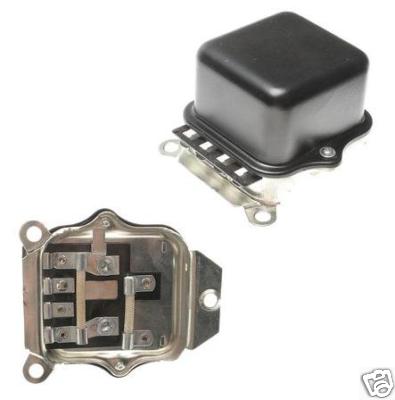


Steering Column: 1956 Ford F-100 pickup. Attached to this steering column is a universal, white horn button. Many people like to refer to this horn button as a "golf-cart" horn button. This horn button was on the coupe during the first movie, and is still on the car today - although there have been photos taken of the car where the horn button has been removed. The white horn button is actually white if you get this brand-new. However, if you buy a piece that is still brand-new, but has been setting on a shelf for a long time, the white starts to turn a yellowish-beige color; so, don't be alarmed if you go to your local auto parts store or eBay and you can only find a yellowish color button. To find these horn buttons, you can go to any local auto parts store, or by going to eBay and typing in "Universal Horn Button." Your price range is going to be anywhere from $3 - $10 each. The horn button sits on top of the column, right below the steering wheel hub. Below this white horn button is a registration holder. This registration holder was on the coupe during the first and second movie; today, it is not on the coupe - and it's whereabouts are unknown. Project THX 138 will be making these correct registration holders in the very near future.

Original White Color

Aging Horn Buttons


Pitman Arm: 1956 Ford truck, chrome plated. Attached to the pitman arm is a '36-'41 Chevrolet tie rod end. This tie rod end is welded to a steel rod, and on the other end of the steel rod is a '48 Ford tie rod sleeve. On the other end of the '40 Ford tie rod sleeve is a '48 Ford tie rod. This whole complete setup has been chrome plated. The only place that it is welded is at the aforementioned Chevrolet piece. Everything is threaded.

Below is a picture of the '48 Ford tie rod sleeve

Steering Wheel: Vintage Ansen 14 inch diameter steering wheel with a 2 inch dish. Wheel is a chromed 3 spoke steering wheel with a black vinyl hand grip. Steering wheel is unique due to hole pattern in spokes. The backing plate is chromed.

Steering Wheel Horn Cap: Was made by Ansen
Non-Functional Horn Cap Made by Ansen

Interior: All interior is black. On the original coupe, red is starting to show through. The seat in the original coupe is an original '32 Ford bench seat. Door panels and seat are done in black vinyl/naugehyde pleats. On the right door “passenger” is the ticket pocket to file all the C.S. The left door also contains chrome trim from a 1956 Crown Vic. The drivers door at one time had this chrome trim, but it is now missing. The driver’s door is also missing the window frame.
Dash Panel: Stock 1932 Ford with a vintage and very rare Stewart Warner 8-gauge stainless panel. This panel is now available through New Age Motorsports
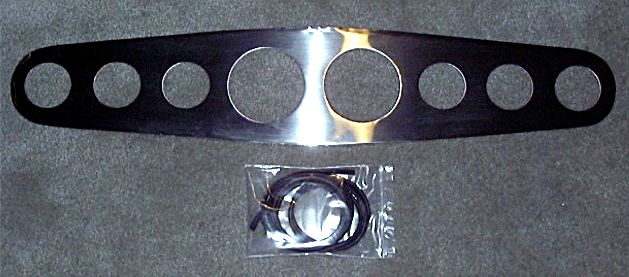
Gauges: The gauges are Stewart Warner. The order of the gauges from left to right are as follows: fuel, oil, amperes, tachometer, speedometer, vacuum, water, water (yes 2 water gauges). Only three of these gauges are the winged gauges. The winged gauges are the oil, amperes, and tachometer.
Correct Gauges
in Correct
Order








Steering Column Drop: Vintage Offenshauser 4 inch drop with the hole for a column shifter. In this column drop there are two holes which have to be custom made. On the left is a toggle switch for the electric fan, and on the right is the ignition. On the far left of the dash panel, on the very bottom, is a little chrome toggle switch. This toggle switch is the shut-off to the electric fuel pump.




Fuel Pump Switch pictured below

Left of the steering column, under the dash is the switch that operates the headlights. On the right side of the steering column, on the dash panel is a button, which is the starter for the car.


Shifter: The shifter on the car today is a Hurst shifter, topped with a vintage Cal Custom piston shift knob. The shifter in the movie was an Ansen shifter with a vintage Cal-Custom piston shift knob. The Ansen shifter handle will be made by Project THX 138 in the near future. This handle will bolt directly into your Hurst shifter. Below is a picture of the original Cal Custom Piston shift knob. Below this picture are three pictures from different views showing the original Cal Custom piston shift knob (on the right) compared to the store-bought piston shift knob (on the left) that you can buy in any auto parts store. Notice the big differences?




Shifter Bracket: This is a Hurst shifter bracket, that mounts your Hurst shifter to your transmission tail shaft. This is the bracket that is on the coupe today; this IS NOT on the movie version of the coupe.

Rear View Mirror: The original interior mirror is an after-market piece made by a company called Monarch. These rear-view mirrors could be used in a variety of different cars. Please note: if you are able to find an original Monarch mirror, with bracket, the bracket must be altered to be just like Milner's. As you can tell in these three photos below, the tip of the bracket is bent down where the mirror attaches to the bracket. This is done just like John's.
Mirror Hanger: 1960’s VERY RARE JFK Flasher/Flicker presidential campaign button that says “HE WILL WIN” attached to a solid blue garter belt.
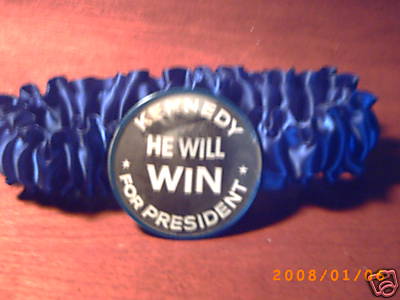
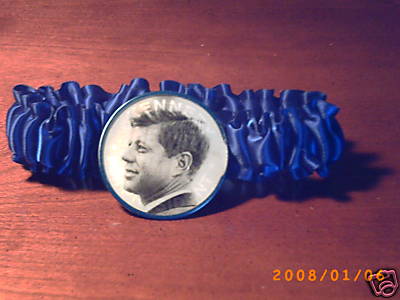
Accelerator Pedal: 1961-1963 Pontiac Tempest. The throttle linkage, which is the piece that is attached to the accelerator pedal, and runs down to the carbs is a '64-'66 Pontiac. I have been told that these were the same throttle linkages used on GTO's 3-deuce setup; however, I have not confirmed this as of the date of this update.
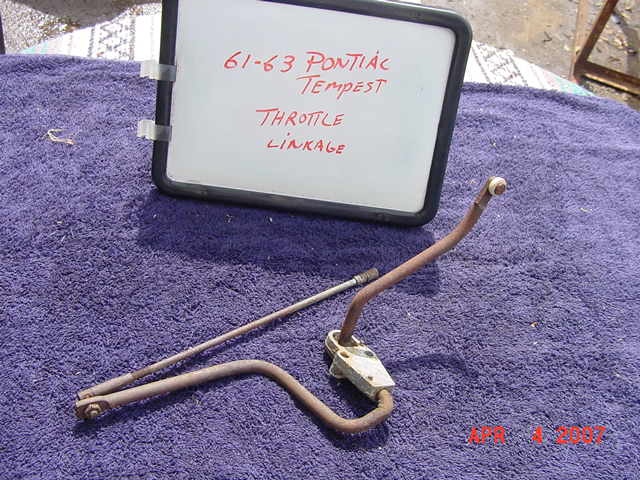
Below is a picture of Correct Throttle Linkage
Rear Fenders: Stock 1932 Ford, and have been bobbed. Inside the rear fenders, the rear well and underside of fenders are painted black/black undercoating. These are available through New Age Motorsports.
Front Fenders: These were painted yellow. Fenders cover only the tread pattern, and not the entire tire width. These cycle fenders are availale at New Age Motorsports. Bracketry has to be fabricated per car.
Front Grill Shell: Stock 1932 Ford grill shell that has been chopped 4 inches. Shell is painted yellow, however, section of shell where crank-hole is has been painted black. (Original movie version - this part was painted yellow, and is not black.)

Grill Insert: Chromed. You can now buy this in stainless, and it is already chopped.

Radiator: Stock 1932 Ford V-8 that has been modified for a small block Chevy. It also has been chopped 4 inches, and has a 1935-36 Chevrolet water neck attached to the center. The radiator cap is a Stant pressure lever radiator cap. We believe that the original radiator hoses are '57 Chevy V8 top and bottom.
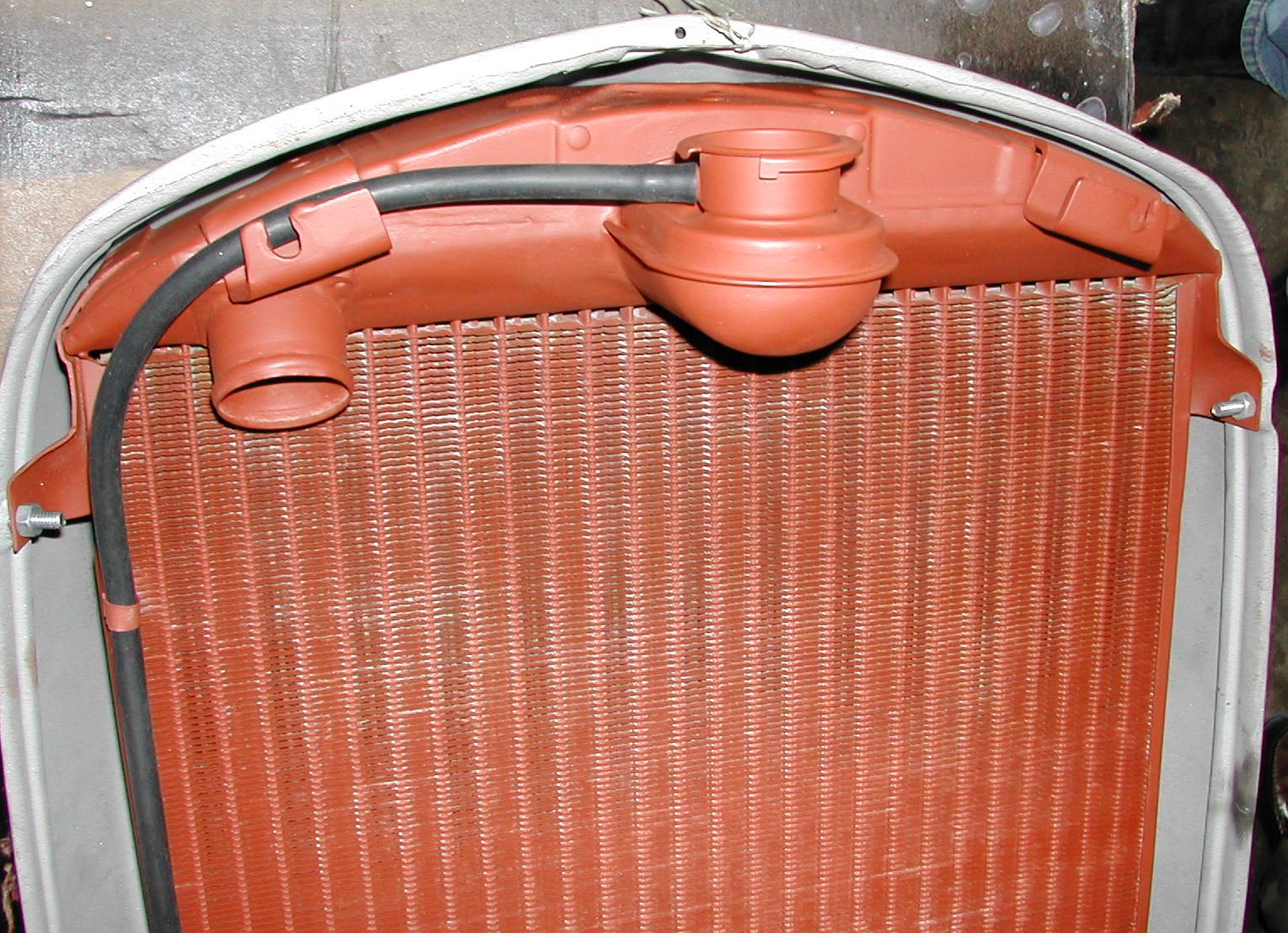

Radiator Support Rods: Attach to the radiator on each side of the water inlet. They do NOT connect in the center like a stock 1932 Ford. (Original radiator support rod bracket on radiator has been split in two and moved to the sides on the radiator. See above picture of radiator for bracket placement.)
Engine: 1966 327 Chevy. This 327 block ('62-'67) is different from a 350 block. The main reason for this is that there is a breather inside the oil valley, which connects to a PVC/vent tube on the back of the block. This allows your block to vent. Without this item, you must vent your block by attaching breathers to your valve covers, or putting an extra oil fill hole in the valve cover with a vented cap. Please note that the oil fill tube with the vented cap already attached to the Man-A-Fre is NOT enough to vent your block!! Please see photo of this early '327 block. As you will see, the extra hole in the back for the vent tube. Also, there is a picture of the breather that sits in the oil valley. The heads on the coupe today are supposedly the camel hump/double humped 202 heads (we have been told that a small block with a Man-A-Fre runs much better with the 1.94 heads as opposed to the 2.02), topped with the Cal Custom 6 finned no-name valve covers. Valve covers also have wing bolts. Engine is painted black.




Picture below is of the breather inside the oil valley.

This is the vent that is on the back side of the block.

Harmonic Balancer: The harmonic balancer in the original coupe is a stock Chevy 6 3/4 harmonic balancer. This harmonic balancer is painted black, like the rest of the engine.
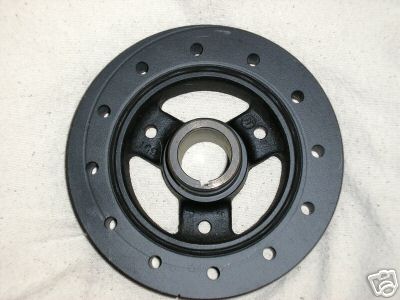
Intake: Is the ever so rare Man-A-Fre. (Atlanta, GA Version)
Carbs: 4 Rochester 2G 2 barrels. Carbs are painted silver. There are two versions of this carb; there is the movie version, which has the fuel inlet coming in from the front, and also on this carb has a vent on the top of the fuel bowl. Today's version of the carbs have the fuel inlet coming in from the side, and the vent on the fuel bowl is no longer there. Both versions of the carbs are a 2G carb, which means no holes for an automatic choke.
Movie version carbs

Air Scoops: 4 vintage aluminum frog-mouth carb scoops. The carb scoops, once again, like everything else on this car, has changed over the years. The original carb scoops had NO set screw, which meant that you could not clamp these down to your carb. The reason for this is that the original carb scoops fit VERY VERY tight. Today's version of the carb scoops have the set screw located on the left side of the scoop. Both sets of scoops are polished aluminum.
Movie Version
Oil fill tube is chromed. Your oil fill tube is your standard early small block Chevy oil fill tube. This can be bought through Speedway Motors, already chromed, including the oil tube vented cap (sold separately).

Water Neck on Intake: Chromed

Spark Plug Wires: Plain red spark plug wires with black ends. These plug wires can be bought in two different places. You can either order them through JEGS, which is their standard JEG plug wire, or you can go to eBay and type in Taylor Universal Plug Wires. Both of these sets will come with your standard Chevrolet ends, which you need to match Milner's. Please note: you do not want HEI plug ends.
Taylor Universal Plug Wires

Wire Looms: There were four different sets of wire looms used on the car. Two which are on the car today (front and back), and two different ones that were used on the Coupe in the movie. Today's version consists of the rear wire looms (closest to firewall) being a set of Mr. Gasket wire looms, part number 9751. These hold four plug wires. The front are a vintage set of Mr. Gasket wire looms, part number 1010, which hold two plug wires. The movie version of the wire looms consist of a vintage set of Cal Custom's on the rear, which hold four plug wires. These are enclosed, and not open - like on today's version. The front wire looms are vintage set of Chevrolet stock wire looms that hold two plug wires (these are very small).
Today's Version


Movie Version


Fan: 15 inch steel fan, which was PROBABLY off of an early Chevrolet 6-cylinder car, or could be a modified '57 Chevy standard/cut-down fan blade. This fan blade can now be bought through Speedway Motors. (Fan will need to be chromed by your chrome plater)

Pulleys: All pulleys are single-groove. Top pulley is chromed, bottom pulley is black. Bottom pulley is 6 3/4" in diameter.
Top Pulley

Bottom Pulley

Oil Pan
Headers: Custom made. These were originally chromed, but now have been hot-jet coated because of their age.
These are now available at New Age Motorsports.
Headlights: Front headlights are vintage Arrow 775H.



Headlight stands: Vintage aluminum finned headlight stands which can be purchased through Speedway Motors. Please note: when ordering these headlight stands, you want the plain finish - NOT the polish finish. (Photo below is of polished headlight stands.)

Rear Tail Lights: 1941-1947 Chevy Rear Tail Lights.

Transmission: The transmission that sits in the original Coupe is a standard T-10 4-speed. This is NOT a Super T-10, like a lot of the magazine articles suggest. The main reason that you do not want to use a Super T-10 is because of the length. This means that if you are running a bench seat in your '32, your shifter handle coming out of the floor sets back further, which is therefore into your seat. Your basic T-10 transmission is a little shorter, and alleviates this problem. A special note for those of you trying to match Milner's car: The T-10 shaft that you are looking for has a Chevrolet bow-tie cast into it. Please see photo below.



Bell Housing: This is a vintage 2-piece bell housing. This is a 1957 Chevy car bell housing, with clutch pedal on the left side. The original Coupe is missing the bottom section. This is a cast iron bell housing. (Note: The clutch fork in the photos is incorrect.) Attached to the bell housing is what I like to call the heavy duty clutch fork. This clutch fork was use on a variety of different cars and trucks. Surrounding the clutch fork is an early '60's rubber Chevrolet clutch fork boot. These can be bought on eBay for around $15. Also attached to the bell housing is the hydraulic slave cylinder. This slave cylinder is made by Raybestos, part number SC36124. This slave cylinder is attached to a home-made steel plate. (Plate is in-between slave cylinder and bell housing.) Please go to WICKED PHOTOS to see how this is set up. Coming out of the slave cylinder is a stock '60-'61 Chevy truck push rod. Please note: These can be bought through Jack Bell's part store.







.jpg)
Engine Mounts: The engine mounts on the original coupe consist of several different parts, all of which are made by Hurst. The first pieces are the original side mounts, which are bolted to the side of the frame. The second piece is the U-cradle mount. This U-cradle sets on top of the side mounts. When using the U-cradle, make sure that you have the original spacer plates that go between the cradle and the engine block. These spacers allow the cradle to not come into contact with the timing chain cover. Please note: there are two different versions of this U-cradle. The first version, which is like Milner's, consists of two mounting holes on each side of the cradle. The second version has four mounting holes, which allows you to use it on a big block, if you so desire. We call this the "Universal Mount." The third piece is the engine cushion mounts. These set in between the U-cradle and the side mounts. These can be bought through Speedway Motors, and are the same as the original Hurst cushion mounts. The last piece is the Hurst anti-chatter rod, and this sets on the top of the U-cradle, directly over each cushion mount. This piece is to keep your engine from chattering when you push in your clutch (if this really works, we do not know - all we know is that they are on the original coupe.)
U-Cradle

Side Mounts

Shackles: Front shackles are 1932 Ford, and the rear are stock 1940 Ford. Front are chromed, rear are just painted black. We suggest using the polished stainless front shackles, which are sold through Speedway Motors.
Lug Nuts: 1969 Pontiac GTO with black nylon insert. These are also known as the Rally II lug nut.


Swing Pedals: Vintage Ansen

Peep Mirror: After-market mirror. Mirror is chromed, and the arm attachment is unique to this mirror.
Rear Bumper: Was a vintage Alfa Romeo front bumper guard may by a company called AMCO (NOT AAMCO - they do tranmissions!). I believe the year is '69-'71. These are very hard to find, and when you do find one they are very expensive. Please take note- this bumper is not a well made bumper, in fact, it is very cheaply made, and will NOT protect you in an accident - it is only for looks. New Age Motorsports has replicated the exact bumper (using the original bumper as a pattern to make a copy); however, the difference with the New Age Motorsports bumper is that it is made out of stainless steel. This is polished out to look just like chrome.
Window Glass: This is stock 1932 Ford; however, rear quarter windows are green,
and rear window is no longer in the original coupe. In the movie, a piece
of plexi-glass was nailed to the original woodwork of the rear window.
This piece has been discarded, therefore no rear window is in the original car.
The original car also does NOT have the rear window roll-down mechanism.
However; it has been brought to our attention that every '32 Ford 5-window coupe
had a roll-down rear window. We highly
suggest you use a roll down window to help cool down on those hot summer days,
as this is part of your air conditioning, when used with a cowl vent or swing
out windshield as this allows the air in the car to flow through.

Fuel Pump: This is an electric fuel pump, Carter P4594 Universal Rotary Vane Electric Fuel Pump is what is on the coupe today. Movie version looks to be a vintage Stewart Warner, but is undetermined at the present time. We strongly believe that it is the Stewart Warner, and if so, it would be part number 235-A. We have no physical proof of this being the correct part, except for a quick glimpse in a photo showing a silver fuel pump. We do know that the fuel pump was changed out by Steve Fitch. During our interview, this was revealed to us; however, Steve did not remember what the original fuel pump was. The electric fuel pump is located on the left side (driver's side) above the rear axle, attached to the inside of the frame rail. The location of this pump requires you to weld a plate on the inside of the frame rail so the pump can be attached. Please see WICKED PHOTOS page to see how pump is mounted.
Today's Version

Movie Version

Fuel Pump Block Off Plate: The original coupe has a chrome block off plate, which blocks off the original setting of the original manual fuel pump. This part can be bought through Speedway Motors.

Electric Fan: At the present time, we don't know what this is.
Top Insert on Body: Stock black vinyl. For those of you buying a New Age Motorsports body or who have a fiberglass body, you can buy one from Julianos.
License Plate Bracket: The front license plate brackets were originally sold by The Deuce Factory, but as of the time of this writing, The Deuce Factory has gone out of business, so you may want to call some vendors that carry Deuce Factory parts to see if they have them in stock. The rear license plate bracket with light can be bought from Bob Drake. The original rear license plate bracket was a vintage Hollywood Accessories.


License Plates: The license plates on the original coupe during the first film and today are a vintage set of 1956 California license plates. The rear license plate has a 1962 DMV sticker attached to the plate. The front plate does NOT have this DMV sticker. The license plates on the original coupe in the second movie were a set of 1963 California license plates. Both the first movie and second movie license plates say "THX138". The difference between the '56 - '62 license plates and the '63 license plates is that the colors are reversed. The '56-'62 plates are a yellowish-orange color with black letters. The '63 plates are reversed, with a black plate and yellow letters.
Front License Plate

Rear License Plate

Second Movie License Plate

Door Handles: The outside door handles are stock 1932 Ford. The inside door handles are also stock 1932 Ford, along with window cranks.
Interior Handles

Camera Brackets: There are various camera brackets welded to the frame, which basically are a 1x1 section of square tubing. Front brackets on the spreader bar are home made. These are available at New Age Motorsports. These brackets were used for towing the coupe around during filming. We refer to these as "tow brackets".

Trunk area is done in tuck and roll finish with a plywood box covering the gas tank. The gas tank is unknown at this time. The plywood box in the movie was in its natural color. Today, it has been painted black, and has a positraction warning decal on top.
Decal on top of black plywood box

The alternator is an early '70's AC Delco Alternator. The top alternator arm is actually a 1957 Chevy generator adjustment arm, stamped with the number 3704884. There are two versions of this adjustment arm: one has the numbers stamped upright, and the other has the numbers stamped upside down. To match Milner's you need to have the arm with the numbers stamped upside down. The lower two alternator brackets consist of two different type of braces/brackets. The first being the front lower brace, which is a '70-'74 454 upper alternator brace. The lower rear brace is a lower alternator bracket from a '69-'74 big block Chevy. Please note that there are different types of these lower brackets that are sold throughout the web. The one you seek is completely flat, with no grooves or indentions. Both of these lower braces/brackets can be purchased through our part suppliers (see PARTS SUPPLIERS page).
Upper Alternator Arm

Front Lower Brace

Rear Lower Bracket

Fuel Filter: AC Delco GF61 or GF61P. Depending upon which size of fuel line you are running. If you are a running a 5/16" fuel line, you want to run the GF61. If you are running a 3/8" fuel line, you will use the GF61P. Coupe version is the GF61P with 3/8" line. Please note that this fuel filter is on the car today, and was not used on the coupe during filming. Fuel filters are painted black, top is painted silver.

Brake Junction: There are two different brake junctions located on the original coupe. The first junction is a '30's-'40's, maybe '50's Studebaker brake junction. This is located directly under the driver's seat, in front of the K member. The second brake junction is from a '60's Dodge Super Bee. This junction is a splitter, allowing two different brake lines to go to the rear drums. This is located on top of the K member. Attached to this junction is a brake pressure switch. The actual brake pressure switch that is used on the coupe is unknown at this time. However; I am using a brake pressure switch from a '40's model Willys coupe. The reason I am using this is because it screws right into the brake junction without any modifications. Please see WICKED PHOTOS for locations.
Studebaker Junction
Dodge Super Bee Junction
Willys Brake Pressure Switch
Parts Assembled
Emergency Brake Cable Brackets: This is the one thing that we are not giving away the identity of, at the request of "The Guru". These brackets are located on the traction bars. They are bolted to the back side of the traction bar (meaning under the body). There is one bracket per traction bar, and only one bracket has the emergency brake cable running to it, which is the left side bracket (driver's side). This bracket is accepting the '57 Chevy's emergency brake cable. Once this cable is put into the bracket, this is where the emergency brake cable ends, as there is NO emergency brake on the original coupe. The reason these brackets were used was to keep the original brake cable from dragging the ground.


Front Brake Line Brackets: The front brake line brackets that are bolted to the frame rails are from a 1965-'66 Ford Galaxy. On these brackets, you must round the corners to achieve the coupe's authentic look. (In the photo below, the corners have NOT been rounded; these are from a stock Galaxy.)

New Age Motorsports & Hot Rods LLC , 501 Pepper St , Monroe CT , 06468
Phone: 203-268-1999 Fax: 203-268-1396 info@newage-motorsports.com